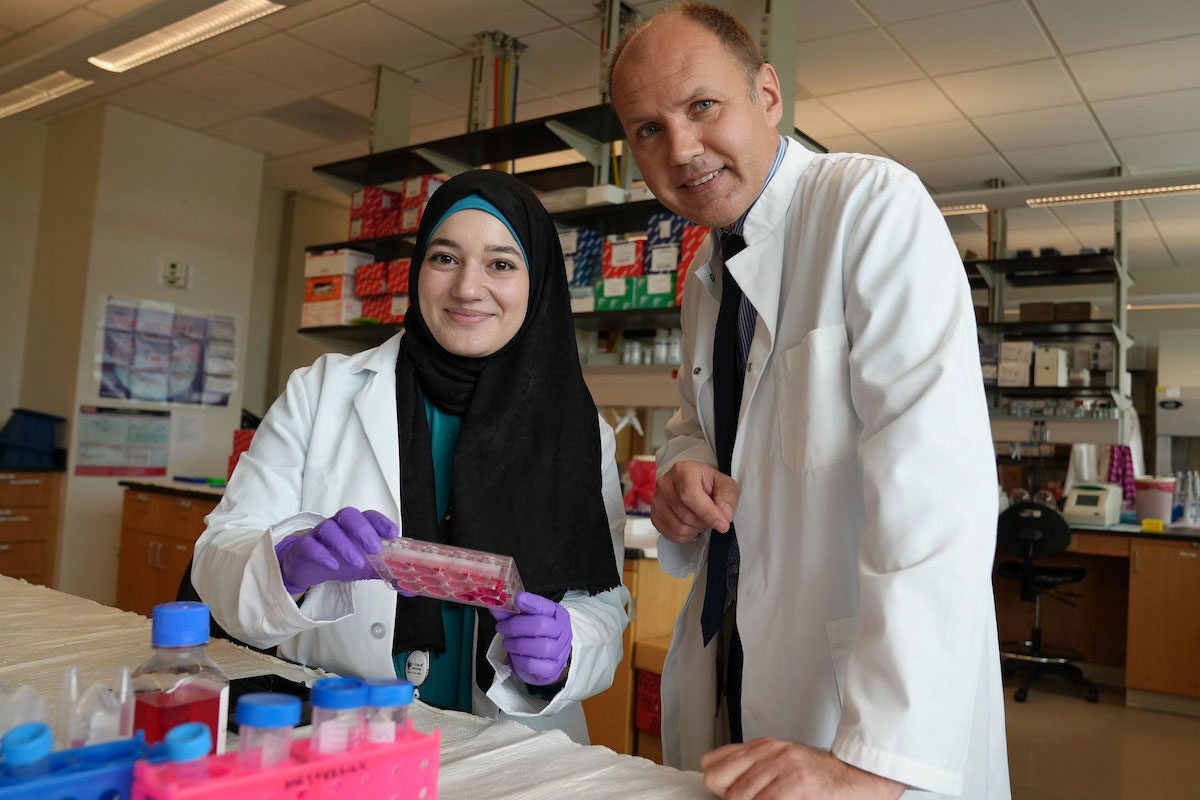Sarah Noureddine ’19 ’21MS ’22PhD won timed chemistry and biology competitions as a high school student. Today, she is tackling bigger challenges — how to age healthfully. And her doctoral research was recently published in the Proceedings of the National Academy of Sciences, one of the world’s most-prestigious multidisciplinary scientific journals.
Noureddine earned her bachelor’s in biology and master’s and doctoral degrees in biomedical sciences at UCF. While a student, she and her College of Medicine research mentor, Michal Masternak, focused on senescent cells and their role in causing age-related conditions like cardiovascular and neurological disease and Type 2 diabetes.
Senescent cells serve a purpose in childbirth, wound healing and embryonic development. But unlike other cells, as you age, these cells stop multiplying and instead of dying off, remain in the body, releasing factors that can reinforce senescence in neighboring cells and cause inflammation in tissue. They’re like that moldy strawberry in your refrigerator that causes the other strawberries to go bad. So anti-aging scientists have looked at ways to stop the accumulation of senescent cells as a way to protect against common age-related illnesses and organ damage.
Masternak believes he has found the answer in dwarf mice, who are genetically smaller than normal. These mice live 50% to 60% longer and suffer from fewer age-related illnesses. They have less arteriosclerosis or hardening of the arteries. Their brain health and activity is better. They don’t lose insulin sensitivity — a precursor to Type 2 diabetes. Interestingly, they tend to become more obese with age, but do not suffer obesity-related ailments at the same rate as normal, aging mice. The question is, “Why?”
Noureddine discovered that dwarf mice have a higher proportion of stem cells in their fat that produce and secrete greater amounts of a microRNA called microRNA-449a-5p (miR-449a). MicroRNAs regulate the final product of genes by suppressing the production of proteinsand are thus candidates for therapeutic interventions and/or biomarkers of disease. By doing an exhausting gene targeting analysis, Noureddine discovered that while this microRNA decreases with age in normal mice, it remains steadily expressed at youthful levels in dwarf mice. More specifically, she found that this microRNA is highly expressed in stem cells of dwarf mice. In fact, these dwarf mice have 5 to 10 times more miR-449a in their fat-derived stem cells than do normal mice. She believes this microRNA helps protect the body from senescence onset and therefore the progression of age-related diseases.
“Sarah’s findings have a huge impact on future therapies,” Masternak says. He explained that the finding could be used to develop biomarkers to determine when a person begins to lose expression of beneficial microRNAs, such as miR-449a, in fat cells as they age, or could be used in enhancing stem cell therapies to compensate altered expression.
Noureddine is now a postdoctoral fellow in the College of Medicine conducting research with infectious disease researcher Mollie Jewett, who is developing new diagnostics and treatments for Lyme disease.
“I was always drawn to medicine because I wanted to help advance preventative care,” she says. “It’s fascinating to me to be able to solve a problem.”
Noureddine’s work as a student earned her the American Aging Association’s Trainee Travel Award, and she presented her doctoral research at the group’s largest annual aging research meeting. She has produced five peer-reviewed research papers during her time at UCF and successfully obtained research funding from the Learning Institute for Elders, Richard Tucker Gerontology Applied Research Grant. This spring she was honored with the Order of Pegasus, UCF’s top student award.
“I am so proud of Sarah,” says Masternak. “I have worked with many students and each student has a dream. But Sarah is unique. She was always up for a challenge.”




